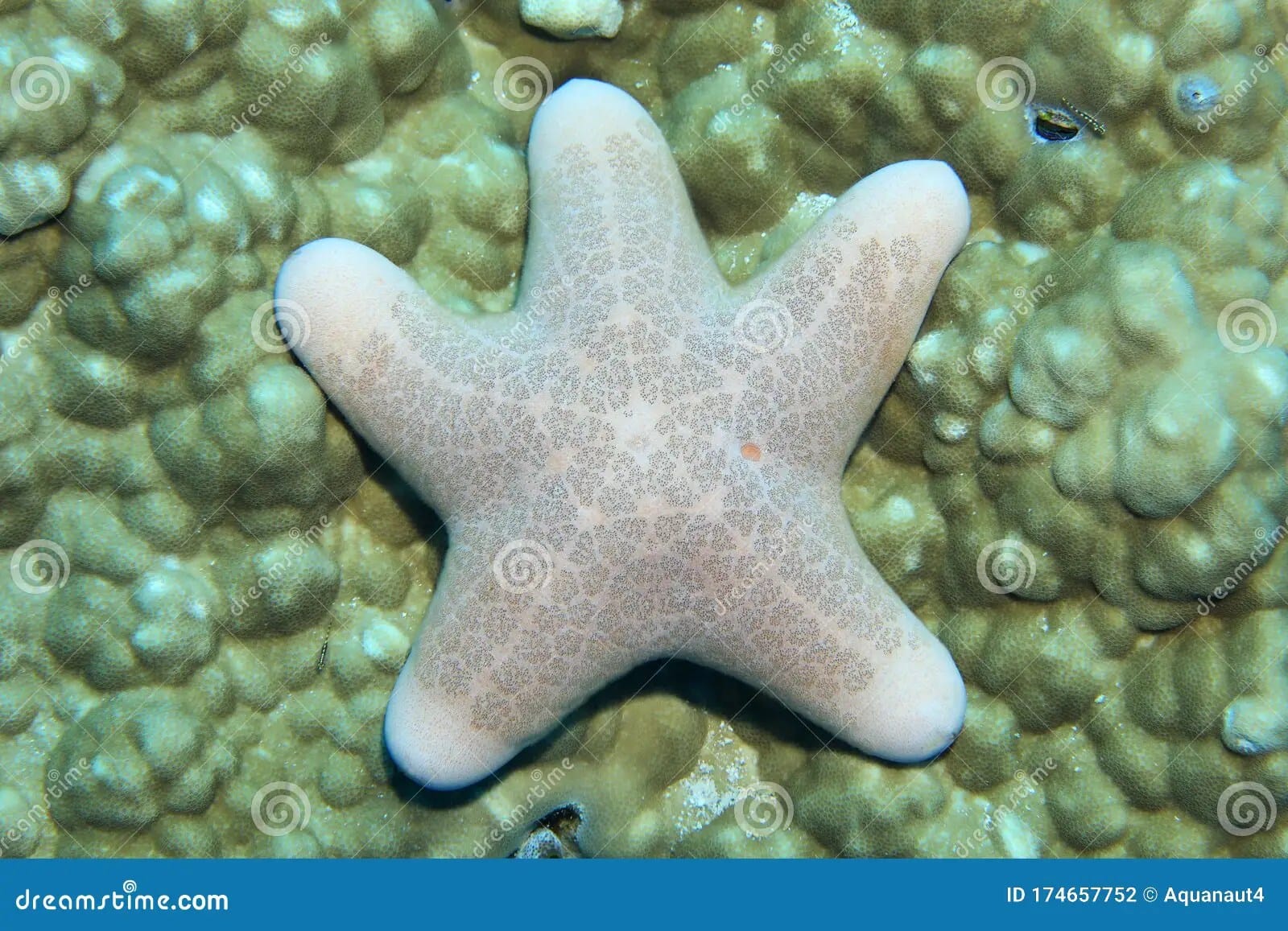The granulated starfish, affectionately nicknamed the “doughboy starfish,” is a captivating creature with unique characteristics. This comprehensive guide delves into the fascinating world of the granulated starfish, exploring its appearance, habitat, diet, life cycle, and the challenges it faces.
Discovering the Doughboy Starfish
The granulated starfish (Chlasterias irregularis) inhabits the warm, shallow waters of the Indo-Pacific. Its plump body and intriguing feeding habits distinguish it from other starfish species. Let’s explore what makes this marine invertebrate so unique.
What Does a Granulated Starfish Look Like?
Instead of the typical long, slender arms of many starfish, the granulated starfish possesses five short, stubby arms, resembling a pentagon with rounded points. Its body has a puffy, cushion-like appearance, and it can grow up to 11 inches in diameter, about the size of a dinner plate. The starfish typically exhibits a pale pink color adorned with tiny brown bumps called papillae, which likely provide camouflage against the reef.
Where Do They Live and What Do They Eat?
Granulated starfish prefer the shallow, sunlit areas of the Indo-Pacific, typically residing on reefs, sandy patches, or rubble. They are carnivores with a peculiar feeding strategy. Instead of directly consuming their prey, they evert their stomachs, engulfing small invertebrates and digesting them externally. This unusual method, known as external digestion, is a key characteristic of this species. You can learn more about other innovative approaches to environmental challenges, such as geosequestration.
From Larva to Starfish: The Life Cycle
The granulated starfish undergoes a complex life cycle, beginning as a tiny, free-floating larva carried by ocean currents. These larvae eventually settle on the reef and metamorphose into juvenile starfish. While the specifics of their reproduction are still being studied, it probably involves spawning, where eggs and sperm are released into the water, followed by the development of the free-floating larvae. This is an area of ongoing research, and our understanding of their reproductive processes may evolve as scientists like Naoki Fukuyama and others continue to study complex systems.
Conservation Concerns
Like many marine creatures, the granulated starfish faces threats from parasites, which can weaken them, and the destruction of their coral reef habitats due to pollution and ocean acidification. They are particularly vulnerable to changes in water quality, highlighting the importance of protecting these vital ecosystems.
Aquarium Care Considerations
Keeping a granulated starfish in a home aquarium is possible but requires careful attention to their specific needs. A large tank with stable water conditions mimicking their natural habitat is essential. Maintaining the correct water chemistry can be challenging, and they need a regular supply of invertebrates for food. Compatibility with other tank mates is also crucial, as some fish or invertebrates might prey on the starfish, or vice versa.
What Do Granulated Starfish Eat?
The granulated starfish, Choriaster granulatus, also known as the doughboy starfish, is an opportunistic omnivore with a carnivorous preference, playing a vital role in the coral reef ecosystem.
The Doughboy’s Diet
These starfish primarily feed on small invertebrates like mollusks (snails, clams), crustaceans (shrimp, crabs), and worms. They also scavenge dead organic matter (carrion), contributing to the reef’s cleanliness and health.
A Unique Dining Style: External Digestion
Granulated starfish employ a remarkable feeding strategy. They push their stomach out through their mouth, enveloping their prey and digesting it externally before retracting their stomach to absorb the nutrients.
Ecological Role
By consuming invertebrates, granulated starfish help regulate their populations, maintaining the delicate balance of the reef ecosystem. Their scavenging habits further contribute to a healthy reef environment. Ongoing research suggests their role may be even more complex, influencing nutrient cycling and other vital processes within the reef.
Where Does the Granulated Sea Star Live?
The granulated sea star (Choriaster granulatus), also known as the doughboy starfish, thrives in the warm, shallow waters of the Indo-Pacific region, stretching from the Red Sea to Australia’s Great Barrier Reef.
Preferred Habitats
These starfish favor sandy bottoms and rubble slopes near coral reefs, offering both comfort and safety. They can burrow into the sand for protection and find ample food sources in these areas.
Depth Range
While they are not deep-sea dwellers, granulated sea stars are found at varying depths, from just a few feet below the surface (around 1.5 meters) down to approximately 53 meters. This range allows them to explore diverse underwater landscapes.
Distribution
Granulated sea stars are frequently observed around the Great Barrier Reef, the Red Sea, and the eastern coast of Africa. However, ongoing research may reveal additional habitats and potential shifts in their distribution due to environmental factors.
How Big is the Choriaster Granulatus?
The Choriaster granulatus, or granulated sea star, is a relatively large starfish.
Size and Shape
A fully grown granulated sea star typically reaches a diameter of around 25 centimeters (10 inches), roughly the size of a dinner plate. Unlike starfish with long, slender arms, the doughboy starfish boasts a plump, cushion-like body with five short, rounded arms.
Appearance
The granular texture of its skin, covered in tiny bumps, contributes to its common name. Its color is typically a mottled mix of pink and brown, offering camouflage within the coral reef. Color variations can occur due to factors like location, diet, and age. Some individuals appear more brownish, while others display more pinkish hues.
Key Points about Granulated Starfish:
- Appearance: Short, stubby arms; Puffy, cushion-like body; Pale pink color with brown papillae
- Habitat: Warm, shallow waters of the Indo-Pacific; Found on reefs, sandy patches, or rubble
- Feeding Habits: Carnivorous; External digestion
- Life Cycle: Develop from free-floating larvae
- Threats: Parasites; Coral reef destruction (pollution, ocean acidification)
- Aquarium Care (if desired): Requires a large tank with stable water conditions; Needs a regular supply of invertebrates for food; Incompatible with some tank mates
This enhanced article provides a more comprehensive and engaging exploration of the granulated starfish, covering its key features, ecological role, and the importance of its conservation. The inclusion of internal links adds value and encourages further exploration of related topics.
- Georgia Platform: A Southern Strategy, 1850s - March 31, 2025
- How many weeks is 40 days: Quick Conversion Guide for Accurate Results - March 31, 2025
- How many feet is 300 meters? 984 Feet: Understand Length Conversions Easily - March 31, 2025





![[History of EMS Timeline]: A Journey from Humble Beginnings to Sophisticated Healthcare history-of-ems-timeline_2](https://www.lolaapp.com/wp-content/uploads/2023/12/history-of-ems-timeline_2-150x150.jpg)











3 thoughts on “Granulated Starfish: A Comprehensive Guide (Facts, Identification, & Care)”
Comments are closed.